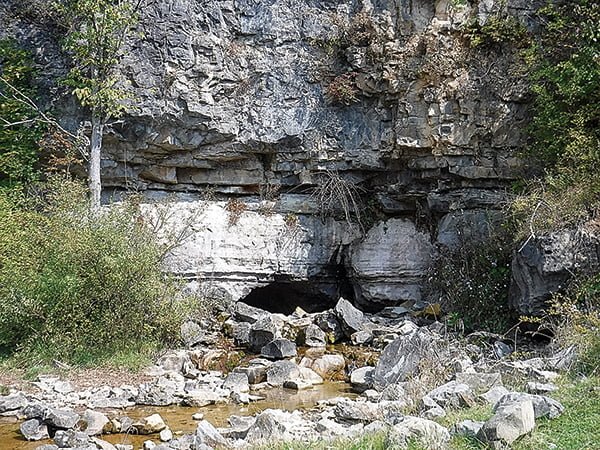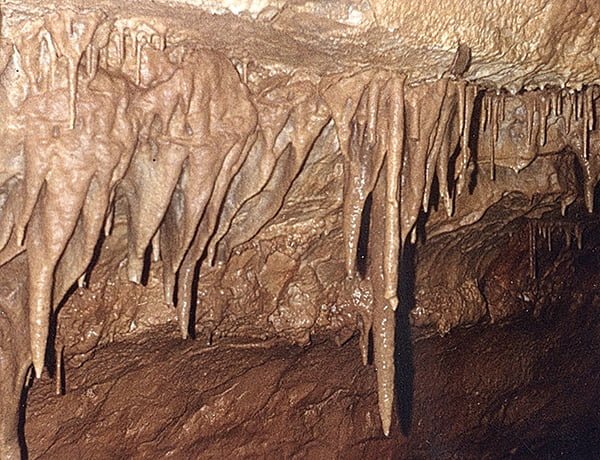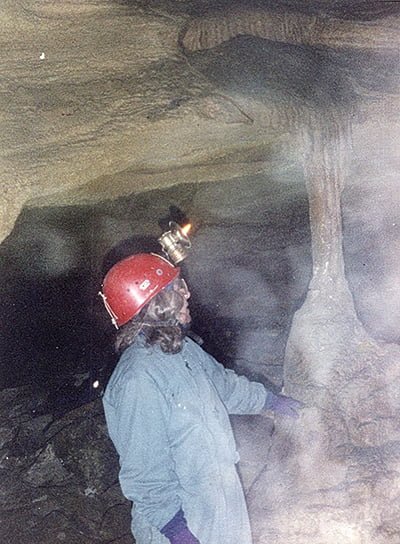
The entrance to Overholt’s Blowing Cave in Buckeye, located on Spruce Flats Road. The cave has more than 2 1/2 miles of mapped passage with several large rooms and waterfalls. Cases of canned food can still be found in one of the rooms – a throwback to the days of stocking supplies in bomb shelters. The property is privately owned and posted.
Roy B. Clarkson
History of Pocahontas County -1981
Any consideration of caves should stress two major aspects:
1. Caves are extremely fragile systems of great geologic and biologic interest. They should be entered only by persons who appreciate the millions of years involved in their formation, and who are dedicated to preserving each feature for viewing and study by others.
Under no circumstance should pieces of the cave be broken, removed or defaced in any way. These acts are also illegal.
No litter should be left in the cave.
“Take nothing but pictures; leave nothing but footprints” is the caver’s motto.
2. Many caves are dangerous to the inexperienced, and entry should be only by those who have the equipment and know-how to safely explore them.
The extensive formations of Greenbrier Limestone in Pocahontas County account for almost all of the hundreds of caves in the county.
These extensive cavern systems have made the region famous worldwide and have resulted in numerous excursions by cave scientists.
In 1976 there were more than 300 known caves and pits in the part of the county roughly north of Marlinton. This area contains about one-half of the 45 square miles of limestone outcropping in the county.
Surveys of the southern part of the county have not been completed but the total number will undoubtedly be far greater than in the northern portion. Some of these are pits or domes with no passages; many others have short passages, and other contain extensive passageways.

Poor Farm Cave is located off Denmar Road in Hillsboro. Reports state “Cave graffiti indicates that the cave has been frequented for well over 100 years.” At left: The Pocahontas Times editor Jaynell Graham in Poor Farm Cave during her spelunking days.

Greenbrier Limestone outcrops, in northern Pocahontas County, follow the Randolph-Pocahontas county line south from the extreme northern tip of the county, to form a narrow band on the west side of the Greenbrier River along the slope of Shavers Mt. and Back Allegheny Mt.
Caves are not present in the northern-most part of the county, probably because of the high altitude. Along the slope of Shavers Mt., 23 caves and pits are known. Most of these are small, the largest being Hooks Cave with a mapped length of 1,350 feet.
Cave development increases along the slopes of Back Allegheny Mt. between Durbin and Clover Lick Valley with 42 known caverns. These range from simple pits with no passages to Cassell Cave with 6.5 miles of surveyed passage and four entrances. It is the largest cave in the county. In this section is also found Cass Cave (Sheets Cave, Suicide Cave), one of the best known caves in the county.
Cass Cave contains one of the highest underground waterfalls in the world (130 feet high) and 2.3 miles of mapped passage. The vertical descent from near the waterfall, 175 feet to the floor of the Big Room, is dangerous and should be attempted only by the most experienced and well-equipped persons. One person lost his life in attempting this descent through the waterfall.
The Clover Lick Valley contains over 60 named caverns. These include several large caves such as Walt Allen Cave with passages reaching 1,540 feet including a 140 foot vertical drop and one of the largest rooms of any cave in West Virginia, and Shinaberry Cave with a surveyed length of 2,800 feet.
Stony Creek Valley contains more than 20 caves including Salmon Cave with 1.26 miles of surveyed passage, and Turkey Roost Cave, a complex cave with 650 feet of passage that have been explored.
More than 60 caves and pits are located in the Big Spring Fork Valley in the northwest part of the county near Linwood. Most of these contain short crawl-ways and passages; however, the largest, Sharps Cave near Linwood, contains a little over a mile of passages and Clay Pit almost one-half mile of mapped passages.
Dry Fork, Douglas Fork and Elk River Valleys contain an additional 60 caves and pits.
These range from pits with or without short passages to Swecker Stream Cave with 1,850 feet of mapped passage and My Cave, largest in the Dry Fork/Douglas Fork Valleys, with more than 6,100 feet of surveyed passage and three entrances…
One concentration of caverns is located in the Little Levels section and on the flanks of Droop Mountain southwest of Hillsboro. Among the caves in this area is Martha’s (Martha Clark’s; Long’s) Cave located 1.9 miles southwest of Hillsboro. This cave contains more than one mile of mapped passage including one large room 600 feet long and 60 feet high with a large waterfall.
Poor Farm Cave, in the same vicinity, contains three passages totaling more than 3,300 feet in total length.
Snedegars Cave, located south of Jacox has two entrances that open into a passage that expands into a room 600 feet long, 40 to 100 feet wide, and up to 40 feet high. The passage continues for more than 1,400 feet. Several other passages form a maze of crawl-ways.
Saltpeter was dug from some of these during the Civil War.
Hills Creek Cave southwest of Lobelia has a large entrance blocked by logs and debris. During high water Hills Creek enters this, connects with the passage of Bruffey Creek and Martha’s Cave, trends to the east and emerges as Locust Creek at Locust Creek Cave, 0.8 miles east of Spice.
Another large concentration of caves and pits is in the Swago Creek area northwest of Buckeye.
One of the largest complexes of caves in this area is Overholt’s Blowing Cave. This cave contains more than 2 ½ miles of mapped passage with several large rooms and waterfalls.
Nearby is Overholt’s Saltpeter Cave, which is not well-developed but was used extensively as a source of saltpeter during the Civil War.
Other caves in this area are Cave Creek Cave, with a large moss and fern lined entrance and more than 1,700 feet of passage, and Tub Cave, which contains one of the largest rooms of any West Virginia cave. This is an oval-shaped room, 625 feet long, 200 feet wide, and 25 to 60 feet high.
Very few caves are in the Devonian/Silurian Limestone formations in the eastern part of Pocahontas County. The part of the county north of Marlinton has only eight, the largest of which, Ralph Sheets Pit east of Green Bank, has passages of only 150 feet.
Further exploration of these formations in southeastern Pocahontas may reveal additional caves, but their number and size is not likely to be very significant.
References: Davies, William E. 1965. Caverns of West Virginia. West Virginia Geological and Economic Survey. Vol. 19(A)
Medville, Douglas M. and Hazel E. Medville. 1976. Caves and Karst Hydrology in Nor-thern Pocahontas County. Bulletin No. 6. West Virginia Speleological Survey.



